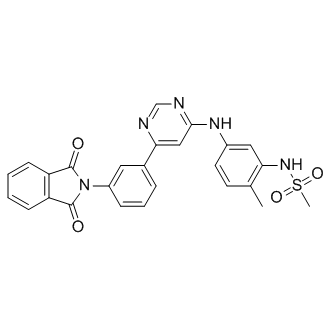
CDK9-IN-1
CAS No. 1415559-43-1
CDK9-IN-1( —— )
Catalog No. M11724 CAS No. 1415559-43-1
CDK9-IN-1 is a potent, selective CDK9 inhibitor with IC50 of 39 nM (CDK9/CycT1), >10-fold selectivity over CDK4 and >100-fold over CDK1/2/3/5/6/7, inhibits HIV-1 replication in cellular assays.
Purity : >98% (HPLC)
 COA
COA
 Datasheet
Datasheet
 HNMR
HNMR
 HPLC
HPLC
 MSDS
MSDS
 Handing Instructions
Handing Instructions
| Size | Price / USD | Stock | Quantity |
| 100MG | Get Quote | Get Quote |


|
| 200MG | Get Quote | Get Quote |


|
| 500MG | Get Quote | Get Quote |


|
| 1G | Get Quote | Get Quote |


|
Biological Information
-
Product NameCDK9-IN-1
-
NoteResearch use only, not for human use.
-
Brief DescriptionCDK9-IN-1 is a potent, selective CDK9 inhibitor with IC50 of 39 nM (CDK9/CycT1), >10-fold selectivity over CDK4 and >100-fold over CDK1/2/3/5/6/7, inhibits HIV-1 replication in cellular assays.
-
DescriptionCDK9-IN-1 is a potent, selective CDK9 inhibitor with IC50 of 39 nM (CDK9/CycT1), >10-fold selectivity over CDK4 and >100-fold over CDK1/2/3/5/6/7, inhibits HIV-1 replication in cellular assays.
-
In VitroCDK9-IN-1 is a potent CDK9 inhibitor that shows high activity against HIV-1 replication.
-
In Vivo——
-
Synonyms——
-
PathwayAngiogenesis
-
TargetCDK
-
RecptorCDK
-
Research AreaInfection
-
Indication——
Chemical Information
-
CAS Number1415559-43-1
-
Formula Weight499.541
-
Molecular FormulaC26H21N5O4S
-
Purity>98% (HPLC)
-
Solubility10 mM in DMSO
-
SMILESCC1=C(C=C(C=C1)NC2=NC=NC(=C2)C3=CC(=CC=C3)N4C(=O)C5=CC=CC=C5C4=O)NS(=O)(=O)C
-
Chemical NameN-(5-(6-(3-(1,3-dioxoisoindolin-2-yl)phenyl)pyrimidin-4-ylamino)-2-methylphenyl)methanesulfonamide
Shipping & Storage Information
-
Storage(-20℃)
-
ShippingWith Ice Pack
-
Stability≥ 2 years
Reference
1. Németh G, et al. Curr Med Chem. 2011;18(3):342-58.
molnova catalog



related products
-
SU-9516 (b)
SU9516 is a selectively potent ATP-competitive inhibitor of CDKs.
-
Compound 919278
Compound 919278 is a specific inhibitor of lymphotoxin β receptor (LTβR, IC50=0.169 uM).
-
Amsilarotene
Amsilarotene inhibits the phosphorylation of retinoblastoma gene product (RB) and increases the presence of 2 cyclin-dependent kinases (CDK) inhibitors resulting in cell cycle arrest.



 Cart
Cart
 sales@molnova.com
sales@molnova.com


